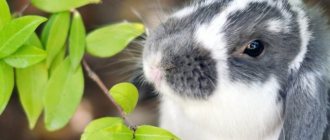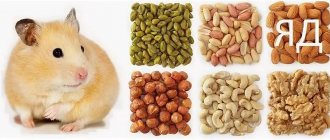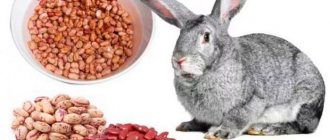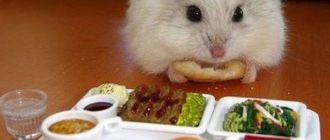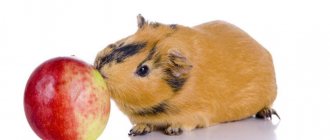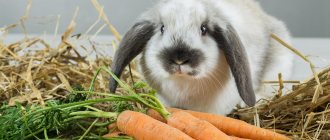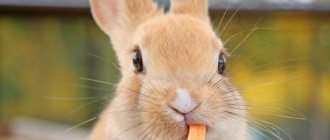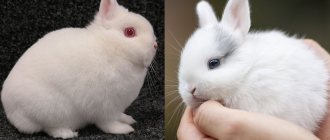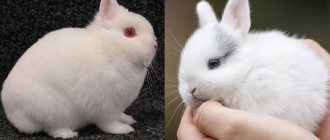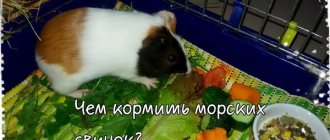Livestock » Rabbits
1
6321
Article rating
Kira Stoletova
Every farmer knows that when breeding any animals, the quality of feeding plays an important role. The quality, quantity and types of feed determine the well-being of animals, their ability to resist diseases, as well as their productivity. And rabbits are no exception in this matter. It is important to know what you can give your rabbit as food, and in what quantities. And it is equally important to understand what kind of food can harm the animal. Because poisoning is no less dangerous than any infection.
What can you give a rabbit?
Which tree leaves can be given to rabbits?
Rabbits happily eat almost any branch food.
And if there are still leaves on the branches, then they will be doubly tastier and healthier. One kilogram of woody greens contains about twenty grams of proteins and 230 feed units. A kilogram of dried leaves contains about 630 feed units and approximately 35-40 grams of pure proteins. This food will be especially useful for lactating females. It is also indispensable in winter cold. The most useful leaves are considered to be acacia. They contain vitamins, microelements, amino acids and, of course, protein. In second place after acacia in terms of nutritional value is elm; maple branches and leaves are of slightly worse quality. You can also give poplar and ash to rabbits. You need to be careful with birch, it has diuretic properties, which can negatively affect kidney function in rabbits.
The leaves of many trees have medicinal properties. So oak and alder are an excellent remedy against diarrhea. The tannins they contain reduce intestinal motility, thereby relieving the symptoms of diarrhea. But you shouldn’t give a lot of these leaves to rabbits, they can cause constipation. They are mainly used as food in the summer, when rabbits suffer from diarrhea due to excess greens and vegetables.
Willow leaves have bactericidal properties and can be used to prevent various infections. Pine needles have a similar effect; in addition, they are an invaluable source of vitamins in winter, when there are no other fresh greens. For medicinal purposes, you can use walnut and sea buckthorn leaves. They have general strengthening properties. Yarrow and plantain are often given as medicine, which can be dried and stored for the winter.
So, here is a list of trees whose leaves are best for feeding rabbits:
- Acacia
- Elm
- Maple
- Ash
- Poplar
- Apple tree
- Grape
- Raspberries
- Birch
But here are trees that have medicinal properties, but their use for feeding is limited:
- Oak
- Alder
- Willow
- Sea buckthorn
- Walnut
0 3904 Article rating
The question of whether it is possible to give leaves to rabbits is asked by every novice rabbit breeder, and every experienced owner answers - it is possible and necessary. We’ll talk further about the benefits of leaf food for rabbits, permitted and prohibited plants for long-eared rabbits.
Is it possible to give leaves to rabbits?
Let's start with an approximate list of plant leaves that are suitable for food:
- nettle;
- raspberries;
- grape;
- strawberry;
- Apple tree;
- poplar;
- elm;
- maple;
- Rowan;
- acacia;
- ash;
- birch.
This list can also be supplemented with leaves of chicory, wormwood, mustard, lettuce, Chinese cabbage, and sunflower. Plus vegetable tops: carrot, beet, pumpkin, radish and celery. They are perfectly digestible and have high nutritional value.
It is generally accepted that rabbits receive the greatest benefit from consuming acacia and elm leaves. They contain many essential microelements, vitamins, amino acids, and protein. The next most important are maple, ash and poplar.
Nettle is the first spring vitamin for rabbits. It is usually mixed with the main feed. For example, finely chopped, steamed together with bran or mixed with crushed boiled potatoes and given to animals in this form.
Raspberry and strawberry leaves also help fight vitamin deficiencies after winter, then they are adequately replaced by grape leaves.
Tree pruning waste can be used as foliage and twig food. For example, grapes are pruned twice a year, in spring and mid-autumn. Leaves and twigs can be safely fed to rabbits. The same can be said about apple trees, pear trees, and raspberries. Spring branches with newly opened buds are especially useful, as they contain a lot of vitamins and biologically active substances.
In autumn you can harvest fallen leaves. They must be fresh, without rot. They are collected in baskets and then dried in well-ventilated rooms. It is better not to give freshly collected leaves to animals; they contain too much moisture. Some livestock breeders advise harvesting after the first frost, but during this period the leaves are often already rotten. But such food cannot be given to rabbits.
You can also give birch leaves to rabbits, but in dosage. Don't forget about the diuretic effect of birch branches and leaves; they can negatively affect the functioning of your pet's kidneys.
There are often debates around lettuce leaves: is it possible to give lettuce leaves to rabbits, is it dangerous? Lettuce leaves are undoubtedly beneficial. They contain potassium, magnesium, folic acid, phosphorus, etc., this is an excellent tool for strengthening the immune system and preventing obesity. But if you overfeed a rabbit with lettuce, you can cause severe poisoning. All because of alkaloids, which are present in the plant in small quantities and, when accumulated, are harmful to health.
You also need to be careful with radish tops, eating which in large quantities is unsafe for the digestive system.
Plant medicines
Oak and alder are not suitable for constant consumption, but they are excellent medicine. Due to the presence of tannins, the leaves of these trees affect intestinal motility and eliminate diarrhea. If you overfeed a rabbit with them, they will cause severe constipation. It’s the same story with willow leaves - they have bactericidal properties and are excellent at fighting various infections, but they are not suitable for regular feeding.
The leaves of plantain, yarrow, sea buckthorn and walnut are components of the “first aid kit” for the eared ear. They have a general strengthening effect on the body and are quite suitable for storing for the winter. It is not recommended to give them daily as the main food.
Occasionally, to prevent diseases, rabbits are given horseradish leaves.
In winter, coniferous trees are a great help. Due to the lack of other greens, they are almost the only natural source of vitamins.
Many novice rabbit breeders ask, is it possible to give leaves to rabbits? The answer is yes, this food is very useful for pets. Like the branches, they contain high amounts of protein and fiber. The leaves, stored for the winter, will make up for the lack of green food. In the fall you can collect fallen ones, but you should watch carefully so that they do not rot.
Nuts are a very valuable product that contains a storehouse of vitamins and nutrients. Among them are vegetable protein and polyunsaturated fatty acids, which ensure the smooth functioning of internal organs. At first glance, the product is healthy for everyone, but is it possible to give nuts to rabbits?!
Despite all the usefulness of this product, it has a harmful effect on the animal’s liver and is very difficult for digestion. In addition, hazelnuts, peanuts and nutmeg are poisonous and can cause severe poisoning, allergic reactions, vomiting, nausea, heart and gall bladder problems. These foods should never go into the feeder. There is no point in risking the life and health of your little ears. In addition, fatty foods are prohibited for rabbits.
Walnuts can also cause serious harm to health. But among all others, it can be called the least evil. It is also not recommended to give it, but if somehow 1 gram gets into the feeder, it will not cause serious problems.
I sometimes use walnut leaves for medicinal purposes, as they have general strengthening properties. No less useful in the diet are yarrow, plantain and sea buckthorn leaves.
Make sure that nuts do not appear in your diet at all. In addition to all of the above, large amounts of fat lead to rapid obesity. They are most harmful during pregnancy and reproduction, as they significantly reduce the chances of impregnating the rabbit.
Nuts are a nutritious product that is a source of saturated fat, vegetable protein, vitamins and other useful substances. They are used in human nutrition, but rabbit breeders are primarily interested in the question of whether it is possible to give rabbits nuts (walnuts, peanuts, etc.) and in what quantities.
Nuts contain a lot of fat, and since rabbits are herbivores, they do not need a lot of fat. In addition, an excess of these substances leads to obesity and negatively affects the liver, so it is impossible to give nuts often, much less feed them to animals every day. This applies to all rabbits, that is, those belonging to the usual meat and downy breeds, decorative and dwarf. From such rich food they quickly become fat, even the young ones; males are reluctant to mate, and females are poorly fertilized.
As a last resort, the fruits can be used, but only occasionally and literally one at a time. But this applies only to walnuts; it is not advisable to feed other types of walnuts (almonds, nutmeg, peanuts, hazelnuts).
Walnuts contain a lot of calcium, which is needed for bone growth, vitamin E and iodine, which prevents the development of coccidiosis. Its fruits have a powerful anti-inflammatory and tissue-restoring effect.
They are given to female rabbits immediately after giving birth to restore the body and increase the nutritional value and volume of milk, and to animals to recover from illness. Babies who drink this milk grow faster and are larger than their peers from other births.
You can treat other animals, including young animals, with walnuts. For young animals, ½ nucleolus every 3 days is enough, for lactating females - a maximum of 1 piece. per day, for females during the rest period, half a nucleolus every 3-4 days.
Rabbits are reluctant to eat walnut leaves, fresh or fallen, since they are not included in the list of “favorite greens.”
Balanced food for domesticated rodents is the primary task of rabbit breeders who breed furry animals. Is it possible to give tree leaves to rabbits?
Green complementary foods are a source of nutrients and vitamins that are necessary for the growth of rodents. Even experienced farmers are afraid to add walnut leaves to young rabbits’ feeders. What leaves can be fed to rabbits?
Leaves can be given to rabbits, but only in limited quantities and only a few times a week. Daily green complementary foods will only be useful together with dry mixtures. The diet of the female rabbit is especially important in anticipation of the offspring. Females are transferred to a separate diet, which should also include green complementary foods.
Leaves from trees provide free food that can be harvested in minutes. Profitable complementary foods can dilute expensive mixtures, but giving any leaves is also not worth it. What does an experienced rabbit breeder give to rabbits? Not only leaves, but also branches are placed in the rodent feeder. The structure of the lower and upper jaws of furry animals allows them to crush solid food. There is no need to worry about rodents' teeth.
Cheap food is also extremely high in calories. Branch food for rabbits contains many active substances, proteins and vitamins. Dried leaves remain beneficial to rodents throughout the year. A prudent farmer who has prepared greens in the summer provides healthy food for rabbits all year round. Dried branches contain up to 40 g of protein, which is especially beneficial for furry animals in winter.
Factory and natural food
Ideally, a pet's diet should contain only natural products. Rabbits living in the wild eat bark, roots, herbs, hay, and some vegetables.
Breeders creating new ornamental breeds of animals do not set themselves the task of breeding animals that can only be fed with canned food or dry concentrates.
Concentrated food, saturated with synthetic vitamins and treated with substances that increase shelf life, can only be used in certain situations for a limited time: when transporting pets to another place of residence, moving.
When regularly feeding animals, when choosing between fresh herbs and mixed feed, it is better to give preference to the former.
Granulated food for rabbits has some features:
- The structure of granules differs from whole hay, vegetables and grass - the structure of the product is unnatural and is less easily absorbed by the rabbit’s body
- Pelleted foods contain less plant fiber, which is necessary for proper digestion.
- By eating more pelleted feed than necessary, animals overeat
- Granular mixtures contain many mineral impurities, which is why kidney stones can form by the second year of an animal’s life.
- Granular feeds consisting of compressed small pieces are not suitable for grinding down incisors: animals simply swallow them
- In the animal’s stomach, dry granules swell, increasing in size several times, which can cause stretching and damage to the gastric mucosa.
Granulated rabbit food should contain the following components:
- plant fibers - 20-25%;
- proteins - 13-15%;
- fats - about 2%.
This food is made from barley grain, corn, oats, alfalfa, legumes, and meadow hay. You can also add vegetables, sunflower cake, bone meal, salt, and chalk to the food. Sometimes vitamins are used as an additive to ready-made granulated rabbit food, the amount of which should not exceed 1%.
The composition of the granule can be determined by its color:
- a light color with a beige, gray or yellow tint means that the composition is dominated by grains;
- bright green color characteristic of grass pellets;
- The presence of vegetables in the granules is indicated by a darker and more saturated shade of green.
The finished food should consist of granules of the same color, which guarantees the stability of their composition. The different pellets in the bag were most likely made in separate batches and then mixed together. The quality of this food is low.
The structure of the granules should be dense and not disintegrate in the hands. Some of them, when transporting large quantities, still crumble, forming grains in the bag, which rabbits eat reluctantly. The quality of granulated feed is higher, the less such grains it contains.
The feed should not contain growth stimulants or dyes. The exact vitamin composition must be indicated on the packaging.
Choosing granular food for rabbits
If you have to feed a decorative rabbit with granulated food for a short time, you need to choose a quality product. The composition of granulated food includes vegetable proteins, carbohydrates, fiber, vitamins, mineral supplements, and raw ash. Pelleted food should be given to animals strictly according to the standards indicated on the packaging.
After feeding rabbits with granulated food for a long time, you need to gradually transfer the animals to natural nutrition. Vegetables and hay should be gradually included in the animal's menu over 7-12 days, reducing the amount of dry concentrated feed. If an animal feels unwell due to a change in diet, it should be taken to an experienced veterinarian.
Which leaves are contraindicated for rabbits?
Not all leaves can be given to rabbits. Many of them are poisonous and can cause serious poisoning in animals. Under no circumstances should rabbits be given elderberry, bird cherry, buckthorn, wolf bast or wolf berries, or lilac. It is not recommended to feed tomato tops and leaves to animals. Although potato tops, which belong to the same nightshade family as tomato tops, are allowed to be given in small quantities. If you don't want to take risks, then don't do this.
Controversy surrounds stone fruit trees such as plum, apricot, peach, sweet cherry, and cherry. It is generally accepted that the bark and foliage of these trees contain hydrocyanic acid, which is poisonous to animals. But many livestock breeders claim that this is not true; hydrocyanic acid is only found in fruit seeds.
In any case, it is better to be careful and limit yourself to leaves from truly safe trees. Radishes are not very suitable for rabbits. If the root can be given without fear. The tops can cause digestive disorders in them.
Contraindications for rodents
For more tasty complementary foods, rabbit breeders experiment with greens and add branches, which, although tasty, are not very healthy for rabbits. Toxic substances cause symptoms of poisoning in rodents; the weakest rabbits may even die. Under no circumstances should elderberries, bird cherry or buckthorn be placed in the feeder of furry animals. Wolf berries and lilacs are poisonous to adult rodents and young animals.
Stone fruit trees can also cause disease in weak rabbits. The rodent's body does not accept radish greens well, but root vegetables will only benefit the animals. Side effects from taking greens include digestive upset and diarrhea.
What leaves should rabbits not eat?
Tree leaves
The leaves of some trees pose a great danger to the health and life of rabbits, since even in small quantities they act as poison. These include:
- lilac;
- bird cherry;
- wolf's bast;
- elder;
- buckthorn;
- apricot;
- plum;
- peach;
- cherry;
- cherries.
The seeds of the fruits of the last five trees contain poisonous hydrocyanic acid and cyanides, which can turn into a nerve poison. Therefore, it is believed that the bark with leaves may also contain a small percentage of this substance. It’s not worth risking the animal’s health, because there are plenty of other, safer trees and plants around.
A unanimous opinion has been formed regarding tomato tops - they should not be given to the big-eared animals as food. The attitude towards potato tops is not so categorical. But potatoes are a nightshade family, just like tomatoes, so not all rabbit breeders approve of this choice. Rhubarb and indoor plants are also not the best option for feeding rabbits.
Not all leaves are created equal
Leaves of white and red cabbage can be found in your fluffy's feeder, but they cause increased gas formation, fermentation, etc. For this reason, it is better to classify it as a prohibited product.
Leaves of celandine, belladonna, dope, and buttercup pose a mortal danger to long-eared pets. You should be extremely careful when collecting plants for animals.
The leaves of the trees are not just nutritious, they have medicinal properties. If a farmer gives green food to all rabbits, the herd gets sick less and can more easily withstand sudden temperature changes. The leaves of the trees help against various diseases; domestic rodents can suffer from them. Helping rabbits get rid of tree leaves is as follows:
- Walnut leaves help against diarrhea (loose stools) and various digestive system disorders. To treat rodents, you will need broken walnut leaves that have just begun to grow. Old stems are less nutritious and healthy. Walnuts can be used to make dried food for the winter.
- Oak leaves are needed to destroy bacterial diseases. The bactericidal properties of tannins are used to treat humans and are suitable for rabbits. Using oak branches you can prevent infectious diseases in rabbits.
- Coniferous branches are needed to maintain the immunity of rabbits. Coniferous branches are used in the winter season, when problems arise with other greenery. The vitamins contained in pine needles help strengthen the rodent’s body’s defense mechanisms. Maple leaves or crushed strawberry stems have similar properties.
- Grass that will protect rabbits from any diseases grows in the fields. You can feed rodents with carrot tops, yarrow and plantain. You can prepare such grass in the summer and give it to rodents in dried form along with dry mixtures in the winter. Herbs strengthen the immunity of rodents and help them survive the cold season.
Use oak branches, rhubarb, alder and willow in limited quantities.
Green complementary foods will help animals overcome illness or improve the functioning of the digestive system, but such leaves cannot be given constantly. Healthy green complementary foods can harm rodents, especially young animals that have not had time to grow stronger.
The animal world is designed in such a way that a plant that is found in the forest or fields helps rodents get rid of infections or bacterial diseases. The necessary green food is not difficult to obtain, and a prudent farmer stocks up on this type of supplement in the summer. For convenience, the branch is ground, and the leaves are dried and placed in small dry boxes.
Contraindications for rodents
For more tasty complementary foods, rabbit breeders experiment with greens and add branches, which, although tasty, are not very healthy for rabbits. Toxic substances cause symptoms of poisoning in rodents; the weakest rabbits may even die. Under no circumstances should elderberries, bird cherry or buckthorn be placed in the feeder of furry animals. Wolf berries and lilacs are poisonous to adult rodents and young animals.
Stone fruit trees can also cause disease in weak rabbits. The rodent's body does not accept radish greens well, but root vegetables will only benefit the animals. Side effects from taking greens include digestive upset and diarrhea.
How to prepare leaves
Leaf food is easy to prepare. In eight hours in the forest, one person can collect from one and a half to two tons. This amount will be enough for a small livestock throughout the winter. Harvesting branches of deciduous trees is best done in June and July. The leaves at this time are juicy, fully formed, and contain the most protein and fiber.
Tree pruning waste can be used as foliage and twig food. For example, grapes are pruned twice a year, in spring and mid-autumn. Leaves and twigs can be safely fed to rabbits. The same can be said about apple trees, pear trees, and raspberries. Spring branches with newly opened buds are especially useful, as they contain a lot of vitamins and biologically active substances.
In autumn you can harvest fallen leaves. They must be fresh, without rot. They are collected in baskets and then dried in well-ventilated rooms. It is better not to give freshly collected leaves to animals; they contain too much moisture. Some livestock breeders advise harvesting after the first frost, but during this period the leaves are often already rotten. But such food cannot be given to rabbits.
Prohibited Products
Inexperienced breeders make the mistake of offering rabbits treats from their table. Some products pose a serious danger - they cause disruption of intestinal function and even death of pets. Not all herbs are suitable for feeding fur-bearing animals. Poisonous plants are deadly. It is important to know what rabbits are not fed so as not to harm them.
Poisonous plants
Eating some herbs is associated with unpleasant consequences. Among meadow and steppe plants there are many poisonous ones. Even in small quantities they are dangerous for pets. Here is a list of herbs that are unsuitable for consumption:
- buttercup;
- hemlock;
- celandine;
- digitalis;
- hellebore;
- sleep-grass;
- pestilence saffron;
- cicuta;
- callas;
- marsh marigold;
- delphinium;
- spurge.
After eating poisonous plants, your pet may experience limb cramps, vomiting, diarrhea, and sometimes a slow heart rate, drooling, and urinary retention. Owners of rabbit farms and domestic decorative rabbits need to learn to distinguish beneficial herbs from potentially dangerous ones.
Sweets
You should not feed rabbits all kinds of sweets - sweets, cookies, buns and cakes. There is nothing beneficial for animals in such food, but there are harmful additives in the form of sugar, preservatives, dyes and thickeners. Eating sweets often leads to severe allergic reactions, intestinal upset and even death of pets.
Nuts
Rabbits should not be given nuts. Their kernels are difficult to digest. Experienced breeders warn that eating such food creates a large load on the liver and gall bladder of animals. After tasting a high-calorie treat, they suffer from vomiting and diarrhea.
Meat and sausages
Herbivorous rodents do not need meat. They get their protein from other sources. Feeding animal foods to rabbits can cause bloating and indigestion. Sausages and sausages are also prohibited products. They contain harmful additives and fat. Such food does not bring benefits.
Herbivorous rodents do not need meat
Dairy
Any food of animal origin is harmful to rodents. Little rabbits drink mother's milk for up to one and a half to two months, and after weaning from the mother rabbit, the animals have no need for this product.
Do not give to animals:
Dangerous vegetables and tops
The tops of tomatoes and peppers are not suitable for rabbits to eat. If the above-ground part of potatoes is fed to rodents, it is in small quantities. Of the vegetables, red beets are dangerous. Its pulp is aggressive; after eating the root vegetable, animals experience diarrhea and their general health worsens.
How are the leaves prepared?
Having decided which leaves can be given to rabbits, you need to make sure that the animals have access to them during the cold season. You will need to work hard and prepare plants in the summer. Moreover, the collection itself takes a day or two, depending on the number of livestock.
Nettle, horseradish, and carrot leaves are excellent. They are indispensable for making mash in winter - they are perfectly stored and retain useful substances. Dry the plants in a place where direct rays of the sun do not reach. It is advisable that it be shady, but dry and well ventilated.
If you decide to collect branches and leaves from trees, it is better to do this at the end of June, maximum in early July. At this time, the leaves are already well formed, juicy, but not yet dusty and have not collected harmful substances from the environment. Brooms are knitted from the branches, as for a bath, and dried under the same conditions as other plants.
You can also pick up fallen leaves, but carefully inspect them to ensure they are free from dirt and rot.
Conditionally permitted food products
Some products, despite the fact that they belong to the group of permitted ones, are fed to rabbits with caution. These include fruits, berries, root vegetables, and grains.
Vegetables
Not all vegetable crops are equally beneficial for rabbits. Some of them offer pets in limited quantities, for example:
- tomatoes;
- onion;
- potato;
- red cabbage;
- radish;
- eggplants.
The listed vegetables irritate the intestinal mucosa and cause bloating. Potatoes can be given to pets, as well as peelings, but provided that there are no green fragments on the tubers. Before serving, the peel is thoroughly washed and the eyes are removed. Root vegetables are offered raw and boiled.
Fruits
Long-eared rodents can be fed with almost all types of fruits, except exotic ones, but you should not overuse them. Experienced rabbit breeders recommend treating animals with a small piece of fruit 2-3 times a week. The diet includes various fruits:
Peeled bananas for rabbits
- peeled bananas;
- melon;
- watermelon and peels;
- apricot;
- any varieties of apples;
- pear.
It is important to alternate different fruits, offering new ones each time. Before distribution, the fruits are washed and the seeds are removed.
Attention! Citrus fruits - oranges, lemons, tangerines - should not be fed to rabbits. Avocados, figs, and mangoes should be added to the list of prohibited fruits.
Berries
The same rules apply to berries as to fruits. They are given a little 2 times a week, observing the animal’s reaction. In case of diarrhea or other digestive problems, the product is excluded.
Rabbits readily eat fruits:
Grains and beans
Despite the usefulness of grains and legumes, not all of them are suitable for feeding rodents. Some foods cause bloating and pain in the intestines, others contain too much fiber, which is difficult to digest. Consider the list of unhealthy legumes and cereals:
- millet;
- rye;
- rice;
- millet;
- green pea;
- red and black beans.
It is especially important for owners of large rabbit farms to remember what they can and cannot feed their rabbits. If mistakes are made when preparing the diet, there is a high risk of losing livestock.
Green food for rabbits
Farmers give walnut leaves to rabbits at their own peril and risk.
Young leaves are a real storehouse of vitamins, but not all types of leaves are beneficial to animals. Rodents living in cages or enclosures are very demanding when it comes to food. Experienced rabbit breeders add only high-quality food to the rodent feeder and select vitamin supplements especially carefully. Leaves of turnips, sunflowers, tomato stems after harvesting tomatoes or Jerusalem artichoke - what can you feed to rodents?
The farmer provides not only dry food, rich in beneficial microelements, but also dry grass in winter or fresh herbs in summer. Lettuce leaves help babies quench their thirst in especially hot weather, and beet stems strengthen the immunity of rodents. If a rabbit breeder does not provide specialized nutritional supplements to furry animals, the furry animals quickly weaken and may eventually become ill.
Twig food is a special treat for rodents, but greenery alone will not keep a herd of rabbits satisfied. Even in summer, you cannot feed animals only grass. A balanced diet is the basis; the health of all residents of the enclosure depends on it. Every farmer, even a beginner, should know what pet furry dogs can and cannot eat.
Feeding standards
The feeder of a decorative rabbit should not be empty, since the consumed food moves through the intestines at the expense of the incoming one. A break in feeding leads to fermentation and rotting of feces, which can cause the death of the animal.
There is no specific rabbit feeding regimen. The main thing is to ensure the constant presence of hay, bark, branches of bushes and trees in the enclosure or cage. Twice a day, other food included in the diet of a decorative rabbit is supplied.
Important! The cage must have a drinking bowl with clean water.
Daily diet of rabbits, feeding characteristics depending on various factors
When developing a diet, factors such as the age of the rabbits and their physiological state should be taken into account.
If rabbits are in a state of physiological rest, then the ratio of food components in their daily diet looks like this:
- dry hay: about 150 g;
- succulent feed: up to 200 g (in winter);
- grass: up to 500 g (in the warm season);
- concentrated feed: 50 g in summer, 60 g in winter.
If females and males are prepared for mating, then the ratio changes:
- succulent food: 200 g (in winter);
- hay: 200 g;
- green food: at least 600 g (in summer);
- concentrated feed: 80 g in summer, 100 g in winter.
For a pregnant rabbit, the diet is organized as follows:
- dry high-quality hay: about 200 g (in winter);
- succulent feed: 200-250 g (in winter);
- green food: at least 700 g;
- concentrated feed: 70-90 g in summer, 100-130 g in winter.
After the female rabbit gives birth and begins feeding them, her diet should be reconsidered. It looks like this:
- hay: about 250 g;
- succulent feed: from 300 to 600 g;
- green grass: 1.2 kg;
- concentrated feed: up to 150 g in summer and about 160 g in winter.
In the summer, the main part of the diet should be green fresh food, which is found in excess during this period. To slightly reduce the excess moisture contained in the grass, you can add a little dry straw or hay to it.
See also: Can I feed rabbits bananas or banana peels?
The main part of the winter diet consists of concentrated feed. Under conditions of low temperature, it is advisable to give warm food to animals.
There is also a separate scheme for feeding young animals in winter (per day). It looks like this:
- rabbits aged 2-3 months: roughage - 55-85 g, concentrated feed - 30-45 g, fruits and vegetables - 95-155 g, chalk, salt - 0.5 g each;
- rabbits aged 3-4 months: roughage - 95-105 g, concentrated feed - 50-65 g, fruits and vegetables - 295-305 g, chalk, salt - 0.6 g each;
- rabbits aged 4-5 months: roughage - 145-155 g, concentrated feed - 75-85 g, fruits and vegetables - 345-355 g, chalk, salt - 1 g each.
In the summer, the diet of young animals looks like this:
- rabbits aged 2-3 months: fresh grass – 295-305 g, concentrated food – 15-30 g, salt and chalk – 0.25 g each;
- rabbits aged 3-4 months: fresh grass - 495-505 g, concentrated food - 40-55 g, salt and chalk - 0.25 g each;
- rabbits aged 4-5 months: fresh grass - 555-560 g, concentrated food - 80-100 g, salt and chalk - 0.25 g each.
Vitamin and mineral supplements should also be added to rabbits' diets. A special need for them arises in winter, when there is little fresh food. Rabbits need the following vitamins:
- A. This vitamin supports reproductive function and affects height and weight.
- AT 2. Makes the coat thicker and smoother, improves the general condition of the body.
- AT 12. Promotes better absorption of protein, strengthens the body of newborn rabbits.
- E. Vitamin improves muscle development, supports the functions of the heart muscle and organs of the reproductive system.
Vitamin supplements given to rabbits include:
- Chiktonik. This complex includes vitamins A, B1, B5, B12, E, K3, as well as a number of amino acids. Chiktonik is well suited for supporting health in winter. Some breeders introduce it into the diet during the breeding season and active weight gain in meat breed rabbits.
- Prodevit. It contains vitamins A, E, D. The product is useful for liver problems, as well as for deficiency of these vitamins in the body.
- E-Selenium. This complex, as the name suggests, contains vitamin E and the trace element selenium. It is used for slow growth of individuals, as well as for disorders of the reproductive system.
Mineral supplements are also used as an additional component, which supplies the required amount of mineral elements, which are especially necessary in the cold season. The most popular are:
- Carly contains vitamins E and B, phosphorus and calcium.
- Gammatonic. The product is used to replenish amino acids in the body of animals.
- Chica. This complex contains carrot and herb granules, phosphorus and calcium.
- Ushastik. It contains a number of vitamins: A, B2, E, B12, copper, iodine, zinc.
Vitamins are also found in feed additives. This:
- grass flour (contains carotene, fiber);
- yeast (contains protein);
- pine flour (contains trace elements and carotene);
- bone meal (contains calcium and phosphorus).


